Spreading the word about your products and services isn’t an easy task. It gets even more challenging because you have limited marketing resources which raises the need for proper management and allocation.
But how do you manage your team of marketers, handle separate workflows, and allocate your budget effectively without burning out?
That’s where marketing resource management (MRM) comes in.
In this article, you’ll learn what MRM is, why it’s important, how to implement it, and the best MRM tools and software you can use.
What Are Marketing Resources?
Marketing Resources
Marketing resources include the budget, people, supplies, and technology required to research, create, distribute, measure, and maximize marketing activities.
Here, marketing activities refer to the programs, campaigns, and projects marketers publish and host to achieve a purposeful outcome.
What Is Marketing Resource Management?
Marketing resource management (MRM) is the planning, scheduling, allocating, and governing of budget, people, supplies, and technology to align these marketing resources with strategic business objectives.
 First let’s break down the aspects of marketing resource management.
First let’s break down the aspects of marketing resource management.
Marketing resource management activities:
- Planning: Managing your marketing resources involves planning at different stages. You’ll need to develop a strategy, ideate your marketing campaigns, plan your marketing calendar, and more.
- Scheduling: With so many things to do and so little time in a day to complete them, it’s a no-brainer to create schedules so you can stay on top of things. MRM tools allow you to create and share these schedules with the rest of your team.
- Allocating: Allocating or budgeting is an integral part of MRM because resources are finite, so assigning them to projects where they’d be most helpful or needed is crucial.
- Governing: Governing is vital to ensure all your marketing materials or assets are consistent across the board.
Marketing resources:
- Budget: A budget is the sum of the money you have to spend on your marketing efforts.
- People: People refers to anybody involved in marketing, selling, or designing a product or service. It also extends to anyone who manages marketing teams.
- Supplies: Supplies are tools used to create and promote products and services.
- Technology: Marketing technology (or MarTech) is the set of software or tools marketers use to achieve their marketing goals or improve marketing efforts.
Alignment:
- Strategic business objectives: These are purpose statements that bridge the gap between a company’s goals and overall vision.
Marketing resource management ensures that marketing teams have what they need to work as efficiently and effectively as possible to ensure their success.
Why Is Marketing Resource Management Important?
Cut Costs & Redundant Expenses
MRM helps marketing managers get a broader view of their marketing operations. This way, managers can easily see where they’re overspending to cut costs. Then, you can choose to save the cut costs or reassign it to other projects.
Improve Team Efficiency & Productivity
You’ll no longer have to worry about whether tasks are being completed, as MRM tools allow you to measure how much work your team is getting done. These tools also improve efficiency and productivity with simple workflows and task automation features.
Remove Silos & Improve Project Handoffs
MRM tools help you create a to-do list and tasks for team members, which often aid project handoffs. In addition, as a central hub, MRM software and tools eliminate silos and make collaboration and communication easier across teams.
Empower Flexibility, Agility, & Nimbleness
Marketing teams must be agile and adapt whenever they confront challenges as they execute campaigns. MRM platforms include features like in-built templating, scheduling, insights, etc., that help these marketing teams remain flexible and agile.
Organize Information To Maximize Its Use & Results
Marketing teams use MRM tools to organize and secure information and other assets with appropriate permissions and controls in a central location. By organizing information in such a manner, all resources and assets are consistent throughout a campaign, no matter who’s handling them.
What Does Marketing Resource Management Do?
Marketing resource management also encompasses responsibilities for operations, work, performance, and asset management. The following are typical responsibilities of marketing resource managers:
Planning:
- Preparing marketing budgets for people, programs, campaigns, and projects
- Planning new hires
- Planning new and additional vendors, agencies, freelancers, and other external partners
- Vetting, selecting, purchasing, consolidating, and maximizing the Martech stack
- Planning media purchases
Scheduling & Allocating:
- Scheduling and allocating team member contributors for specific programs, campaigns, and projects
- Allocating vendor, agency, and freelancer resources to marketing activities
- Dedicating tools and technology to complete work effectively and efficiently
- Allocating budget for all marketing activities
Governing:
- Ensuring brand compliance of all assets created
- Governing, streamlining, and optimizing creative production processes and workflows
- Providing transparency and visibility of marketing activities and collateral
- Managing external vendors, agencies, and freelancer partners
- Coordinating event resources
- Consolidating marketing resources
- Measuring and reporting on performance insights from marketing activities
How To Implement Marketing Resource Management
Now that you know what MRM is and its benefits, let’s examine how you can get started with implementing it in your organization.
1. Establish Marketing Budget Needs
To start, it is crucial to assess your current needs and the resources you have to cover them. This assessment will help you understand how you’re using your available resources and establish your marketing budget needs.
Here are some questions to ask yourself that’d help you create a marketing budget that works:
- What are our marketing goals for the year?
- What are your monthly marketing operational costs?
- What type of marketing assets do we need to create?
- What KPIs are we using to track or measure the success of our marketing efforts?
Answer these questions as accurately as possible because they’ll lay the foundation for managing your marketing resources.
2. Determine People (Human) Resource Needs
After establishing your marketing budget needs, you must determine your human resource needs.
You need to take this step to ensure the tasks within a project are completed by the people most qualified. Determining your human resource needs also helps team members know exactly what to do.
To help you, here are some questions to ask:
- Do you need to make internal hires? Or is it better to hire contractors, agencies, or freelancers?
- Would team members need training to handle marketing projects and campaigns effectively?
- How can you ensure to allocate human resources to projects without over-scheduling?
3. Ascertain Marketing Supplies Needs
With your budget and human resource needs in place, it’s time to evaluate the marketing supplies you’ll need to handle your projects and campaigns.
These marketing supplies are the materials you and your team would need to spread the word about your business. Are you using a blog? Facebook ads? Organic social media posts? TV ads? Flyers? Or something else?
4. Choose Marketing Technology
You cannot wholly implement marketing resource management without MRM tools or software. There are several MRM tools on the market, and it can be overwhelming to choose one.
So how do you determine which tool is best for your team?
Start by prioritizing your team’s needs. And to do this, ask questions like:
- What does your team need to accomplish to be successful?
- What does your current process look like?
- What does your dream marketing process look like?
- How would you like to see your process flow in a new tool?
Next, check whether the tool has non-negotiable features that help your team achieve its goals.
You should also consider some of the tool’s “nice-to-have” features and price.
Once you’ve checked the features and price, rank all the tools you’ve researched using a point system and choose the one that edges out over the others.
The final step will be to pitch the tool to your boss.
5. Set Up Governance Frameworks & Ceremonies For All Resources
It’s not surprising for different team members to create inconsistent marketing resources — which isn’t ideal and leads to extra costs for reworks.
With governance frameworks and ceremonies in place, all team members have all they need to create consistent on-brand marketing resources.
Who Benefits From Marketing Resource Management?
Individual Marketing Contributors
Individual marketing contributors or content creators enjoy how MRM tools streamline and enhance workflows which helps save time and effort. The central resource hub also makes it easy for marketing contributors to get all the information they need in one place.
Cross-Functional Team Members
Team members are one of the biggest benefactors of MRM tools and software. With MRM, teams can eliminate bottlenecks, save time, improve collaboration, plan projects, and more.
MRM helps team members know their roles and responsibilities to achieve an organization’s overarching business and marketing goals.
Marketing Leaders
Marketing leaders use MRM tools to organize and manage each team member’s daily responsibilities. They also use these tools to plan campaigns, marketing strategies, and launches. And also to review the progress of these initiatives.
Executive Leaders
Executive leaders use MRM software to collect and analyze vital metrics and insights that help them measure their campaign’s success. The analytics dashboards on MRM tools help these executive leaders visualize and understand the data they collect.
External Stakeholders
External stakeholders benefit from the collaboration features of MRM tools as it helps them stay in the know throughout a project’s lifetime.
What Features To Explore With MRM Tools
Marketing resource management is a wide-ranging discipline. There is a lot of functionality to consider when researching the purchase of an MRM platform.
The following lists will help you start brainstorming what you may need to implement MRM into your organization.
Budget Management Features
- Supply Cost Attribution
- Media Buy Attribution
- Contributor Time Tracking
Team Management Features
- Content Calendar
- Marketing Campaigns
- Content Supply Chain Handoff Automations
- Marketing Software Integrations
- Kanban Boards
- Task Workflows
- Team Member Capacity Views
- Stakeholder Read-Only Views
- Project Burndown Charts
Vendor Management Features
- Communication & Collaboration
- Ingest Functionality
Digital Asset Management Features
- Audit Trails
- Brand Compliance & Governance
- Sales Enablement Functionality
Performance Management Features
- Project Performance Reports
- Campaign Performance Reports
- Team Member Performance Reports
- Asset Usage Reports
10 Common Marketing Resource Management Tools
Again, because MRM is a broad discipline that requires a comprehensive set of functionality to manage, it is highly likely that you’ll opt for multiple solutions to implement these best practices into your marketing strategy.
The following tools have strengths in some MRM areas but not all. Use this list to research your organization’s marketing resource management software.
1. Marketing Suite By CoSchedule
Marketing Suite is a simple yet powerful marketing project management platform. It’s also built with features that help marketing teams implement resource management effectively.

Here are some features that make Marketing Suite stand out from the rest:
- Workflow templates and social sharing templates that help teams save time and effort, as they’ll never have to reinvent the wheel.
- Built-in social media scheduling to help plan all your social media sharing directly in CoSchedule. That way, you have one less tool to manage.
- ReQueue – an intelligent social automation that helps you re-share social campaigns to drive more traffic to your site.
- Agile view (Team Management Dashboard) to see daily scrum summaries of each team member’s tasks.
- Calendar view to provide high-level views of every campaign, email, social message, etc.
2. Marketing Calendar By CoSchedule
Aside from Marketing Suite, CoSchedule’s Marketing Calendar is another excellent tool marketing teams can use to implement MRM.
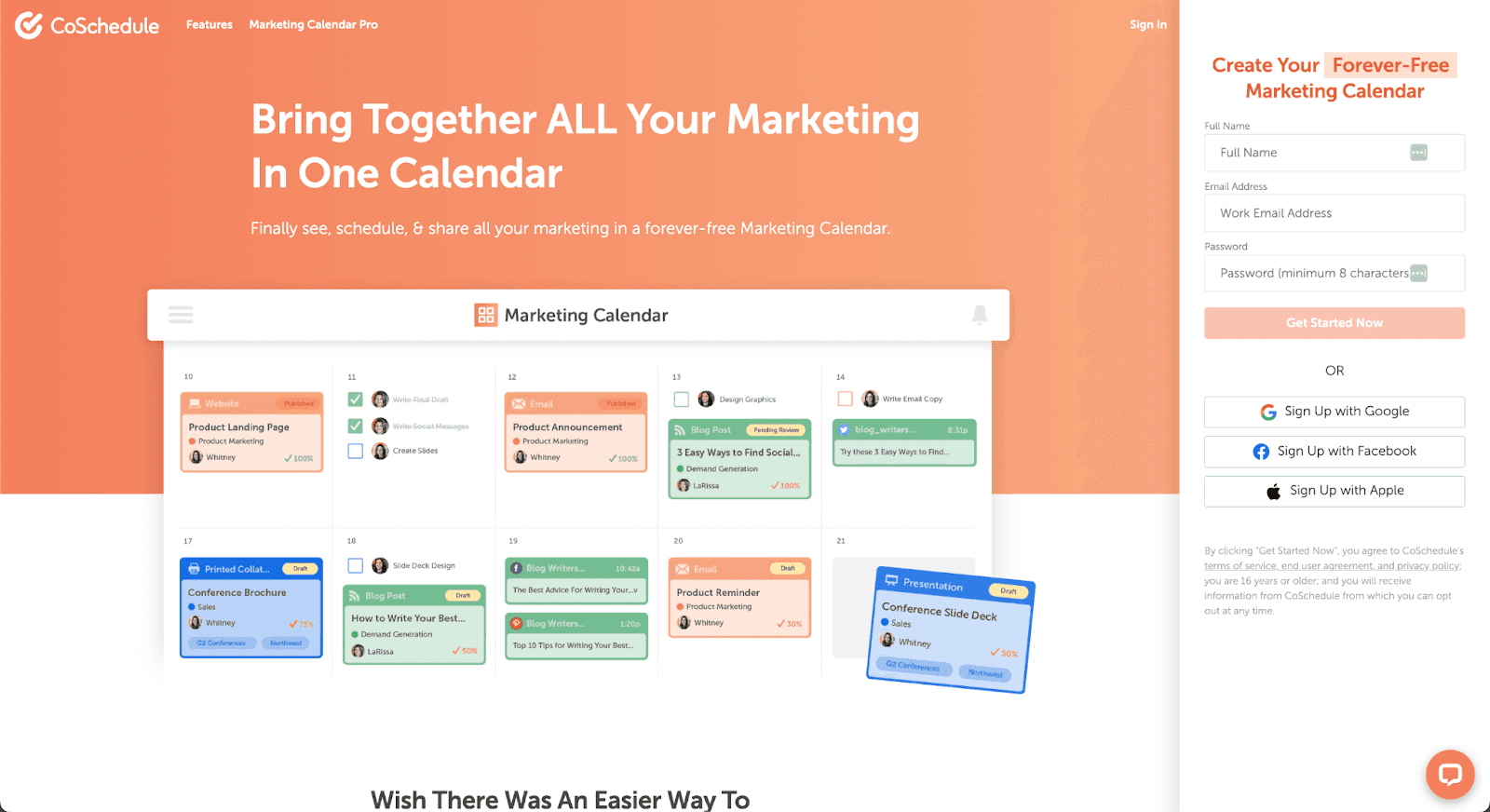
CoSchedule’s Marketing Calendar allows you to manage and gain visibility on all your concurrent marketing projects.
You can use the tool to collaborate with other team members, plan and schedule social posts, and use social reports to analyze the results from your social media campaigns.
3. Wrike
Wrike helps teams of different sizes manage and transform the way they work. The tool is highly customizable, so you can adjust it to meet your team’s specific needs.

Some of Wrike’s key features include customizable dashboards, seamless integrations with other tools, and collaborative cross-tagging.
4. Monday.com
Monday.com is a project management software that helps teams manage workflows to fit their needs. It’s built for any industry, but marketing teams can use it for project management, task management, and more.

This MRM tool is great for coordinating projects and marketing operations.
5. Sitecore Content Hub
Sitecore Content Hub is a central location for all everything that has to do with your content — from ideation to analytics.

This MRM tool comes with robust workflow management features that allow you to streamline content production, customizable strategy boards, visual calendars, and so on.
6. Kintone
Kintone is a great MRM tool if your company would like to track the development & impact of your campaigns in one place, manage content creation and approval with ease, generate custom reports for detailed analysis, and more.

Kintone provides an all-in-one workflow process for not only the marketing team but other branches in your organization as well.
7. SAS Customer Intelligence 360SASA
SAS marketing helps embed marketing resource management directly into daily marketing processes. This software helps teams with marketing data management, marketing planning, customer journey activation, embedded customer analytics, extended marketing impact, and more.

Use SAS customer intelligence for your daily marketing processes.
8. Uptempo
Uptempo is a marketing business acceleration software that helps marketing teams streamline their workflows to save the company time and money.

Uptempo is a useful MRM software with strengths in helping your business plan budgeting and spending.
9. Marmind
Marmind helps with planning, budgeting, and getting the end results that your company desires.

Track budget and spending, monitor performance in real-time and create seamless integrations & workflows all with Marmind.
10. Shopperations
Shopperations is a planning and collaboration platform that offers intuitive interfaces and workflow, which simultaneously saves you and your company time when it comes to finishing tasks.

Shopperations helps with planning and collaboration that saves your marketing team time.
MRM Challenges Marketers May Face
Marketing resource management aims to solve many challenges facing modern marketing teams. However, implementing an MRM system and sticking to it has challenges in and of itself.
Firstly, gaining internal support from the C-suite and your marketing team can be your first hurdle.
Teams grow accustomed to the status quo, even if it’s broken and losing valuable time.
Your C-suite might be reluctant to open the purse strings for another tool. They’ve grown weary of every tool promising the world only to be slowly phased out in favor of the status quo.
This brings us to the first challenge— overcoming the status quo.
MRM Challenge 1: The Status Quo
You might mistake the status quo as the safe choice. After all, it’s what you’ve always done.
However, sticking to the status quo IS the risky option. We live in a change-or-die world.
Think of Blockbuster. They could be Netflix now if they had only taken an early risk on digital streaming rather than sticking to the status quo.
Think of how Facebook has changed the state of marketing. In less than a decade, social media caused our marketing budgets to shift drastically. There are job titles we couldn’t imagine living without that didn’t exist 15 years ago.
Marketing. Moves. Fast.
Do you have time to update that spreadsheet? Or should you be thinking strategically about new campaigns? You’ve got to go all in to hit your goals.
What about your team?
To successfully challenge that status quo, do your legwork and be prepared for some pushback.
- Anticipate questions – spend 30 minutes brainstorming every question your team might have.
- Anticipate roadblocks and have a plan to overcome them.
- Anticipate objections and be ready with a rebuttal.
Humans hate change. We love a good rut… even if it’s wasting our precious time. The longer your team has been following an old process, the longer it can take to change. (*Spoiler Alert* it can take over 21 days to build a new habit.)
This brings us to our next MRM challenge: onboarding
MRM Challenge 2: Onboarding
Start by planning out your roadmap to implementation. It may take your team several weeks to be fully operational with an MRM system.
Getting your game plan ready means you’ve got a day-by-day plan to bring your team up to speed ASAP.
We’ve created an easy-to-follow implementation calendar to help.
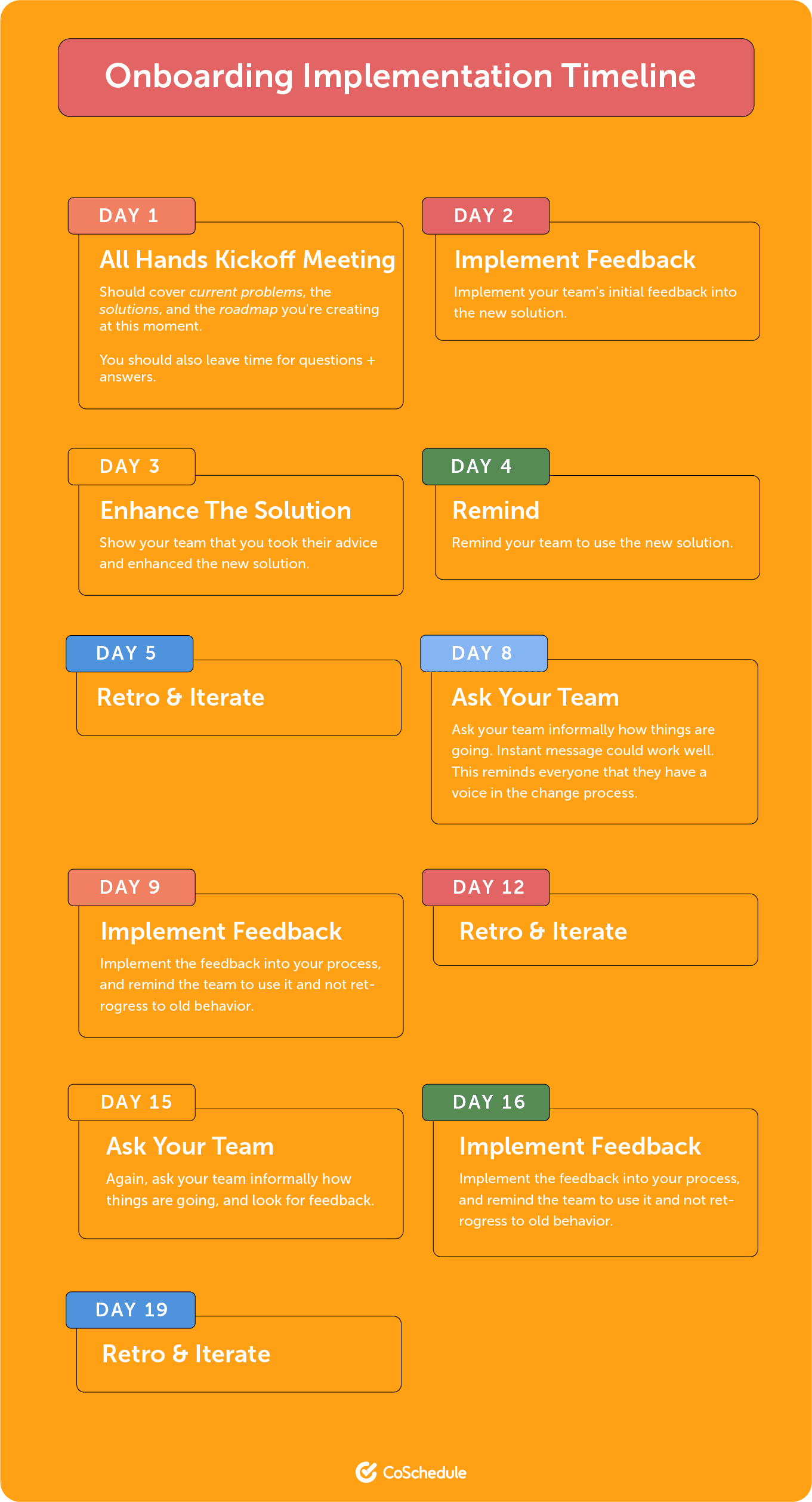
One thing you can do before implementing a tool is to make sure the MRM option you choose has training resources and a dedicated person to assist you in successfully onboarding your team.
MRM Challenge 3: Cost
MRM systems are a serious investment — solutions can range in price from $300/month to $3,000/month or more.
This is an issue you’ll have to be ready to discuss. We recommend coming to the table armed with the tangible impact an MRM system will have on your team’s bottom line.
We’ve laid out a map that tracks back to business goals to appeal to any data-driven CMO.
Time Spent On Pointless Tasks
How much of your time is wasted emailing back and forth? Or searching for the latest version of a graphic? Or a meeting that went over an hour just to get a status update? Measure the hours you and your team spend on these inefficiencies for one week.

Multiply that time by each employee’s hourly wage to show your C-suite how much money your team wastes on admin tasks that add nothing to the bottom line.
Let’s say that your team consists of 5 full-time employees. Each person wastes 10 hours per week on admin and unnecessary meetings. For simplicity’s sake, we’ll say everyone on your team is paid the same $50,000/per year, meaning their hourly wage is about $24/hour.
This means that everyone on your team spends $240/week on unnecessary tasks for a total of about $1,200/week.
Times that by 52, and you’ll see your team is spending $62,400 a year chasing down graphics, approvals, and status updates.
You might as well rake that money into a huge pile and light it on fire.
Improved Oversight
Do you know exactly what everyone on your team is working on at this exact moment?
Think about if someone on your team is only working at 50% capacity simply because it’s impossible to keep tabs on all the projects happening at once.
By understanding who is working on want, you can save money because everyone is operating at their full bandwidth.
Let’s say your designer is paid $60,000/year but only gets enough work to fill 75% of their capacity. Your company is wasting $15,000/year right there.

All because there is a lack of visibility and accountability regarding daily tasks.
We can also view this from the opposite perspective.
People who are overloaded with tasks and feel like they can’t keep their heads above water are overwhelmingly less happy at work.
Being unhappy at work translates into a higher employee turnover rate.
According to a study by The Society of Human Resource Management, every time a salaried employee leaves, it costs an average of 6 to 9 months of their salary to hire a replacement.

Let’s use that same designer as the example. Replacing them will cost your organization $30,000 to $45,000.
And you thought not knowing your team’s daily tasks was just a pain in the @ss.
It turns out it’s also a pain in your company’s pocketbook.
Marketers today are faced with significant challenges like:
- The inability to get everyone on the same page.
- Bouncing from tool to spreadsheet and back again to try to cobble together visibility.
- Proving ROI and showing which campaigns are driving real results.
- And general issues collaborating across a complex team with competing KPIs.
How To Manage Marketing Resource Management With CoSchedule’s Marketing Suite
CoSchedule Marketing Suite is perfect for marketing resource management. Here are a few of the key ways you can coordinate your budget, process, & resources all within Marketing Suite.
Manage Your Budget
Manage your budget within any project by creating a Custom Field for budget spend. This can help you easily track & measure how much you’ve spent on specific marketing projects for any specific period of time.
Add the budget allocated for each project, so you can easily review spend for optimal planning & road mapping.

For example, you can run a report to see your spend on social ads for the month.
Plan For New Hires
Having difficulty justifying the need for additional team members?
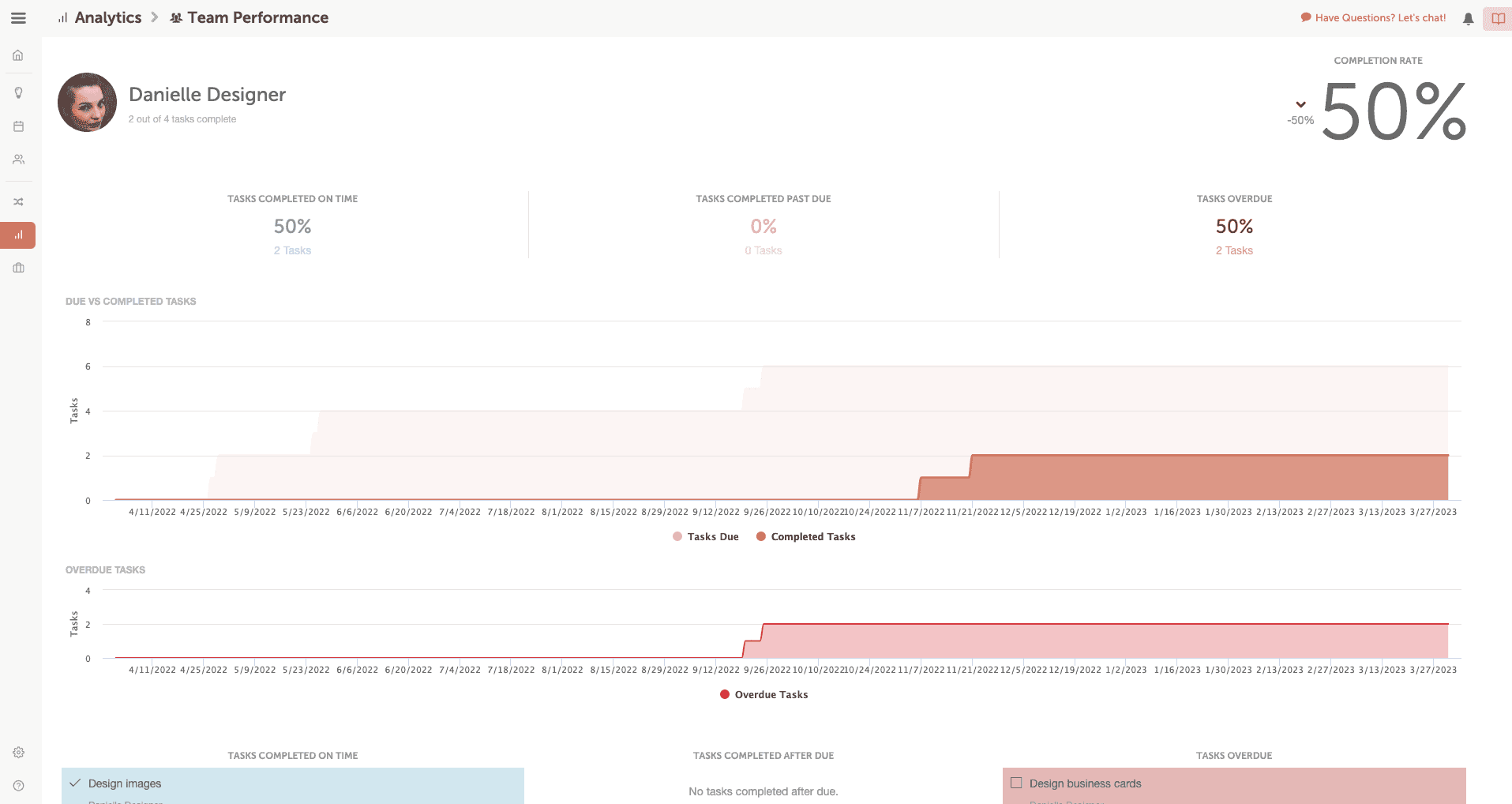
If a designer on your team is constantly overloaded with overdue tasks and projects, you may need to hire another designer on your team to keep up with stakeholder demands.
Use the Team Performance Report to get a view of how everyone on your team is doing, and if you need to make hiring decisions.
Schedule & Allocate Team Resources
Maximize your team’s efficiency with clearly defined workflows. With Marketing Suite, you can easily assign tasks & projects to your team.
Build out reusable Project Templates & Task Templates to standardize workflows to schedule & allocate work across your marketing team. With Marketing Suite, every person knows what they’re working on, and when it is due. This keeps work on time & on budget.
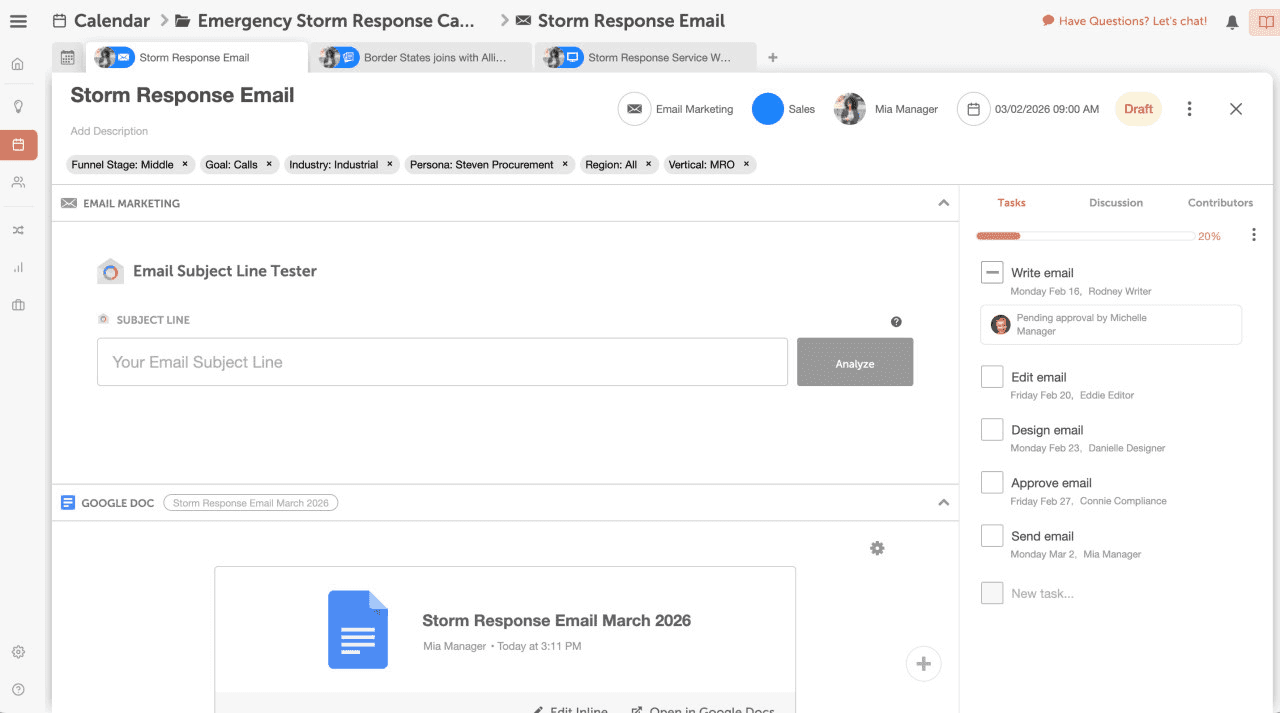
Review the work your team is doing each week with the Team Management Dashboard.
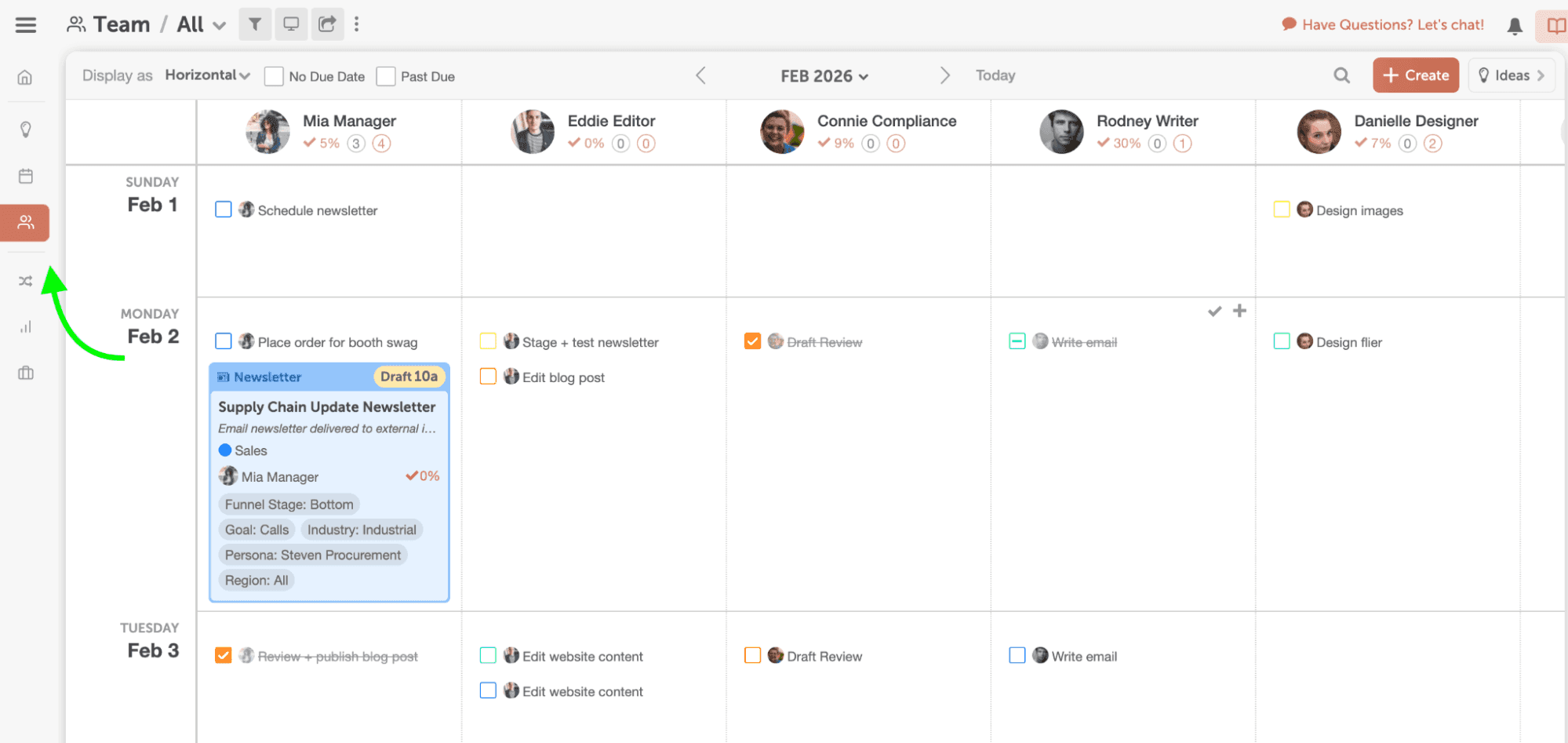
This view helps marketing managers check-in with your team’s progress and ensure everyone has enough work to stay productive all week.
Ensure Brand Compliance Of Assets
Making sure your entire organization is using up-to-date brand assets can be a mess. Without a single asset library for your company to reference, old files and resources end up getting used in the sales process, customer training, employee onboarding, & more.
To ensure everything that is in use is in the latest version… then add it to your Asset Organizer.
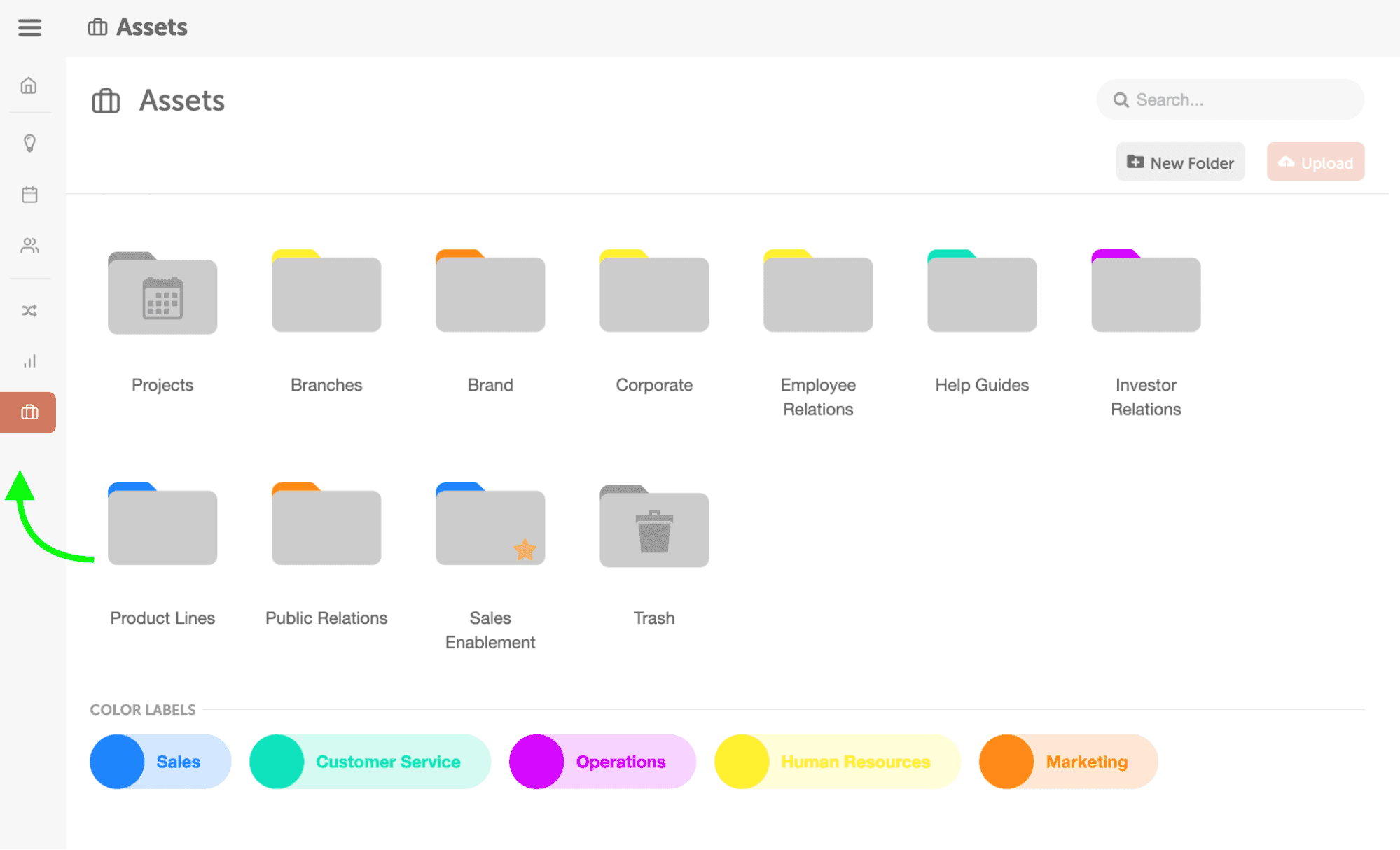
Asset Organizer serves as the hub to share & distribute the latest assets across your organization.
Provide Visibility of All Marketing Activities & Collateral
Use the Idea Board for total visibility of scheduled & planned work.
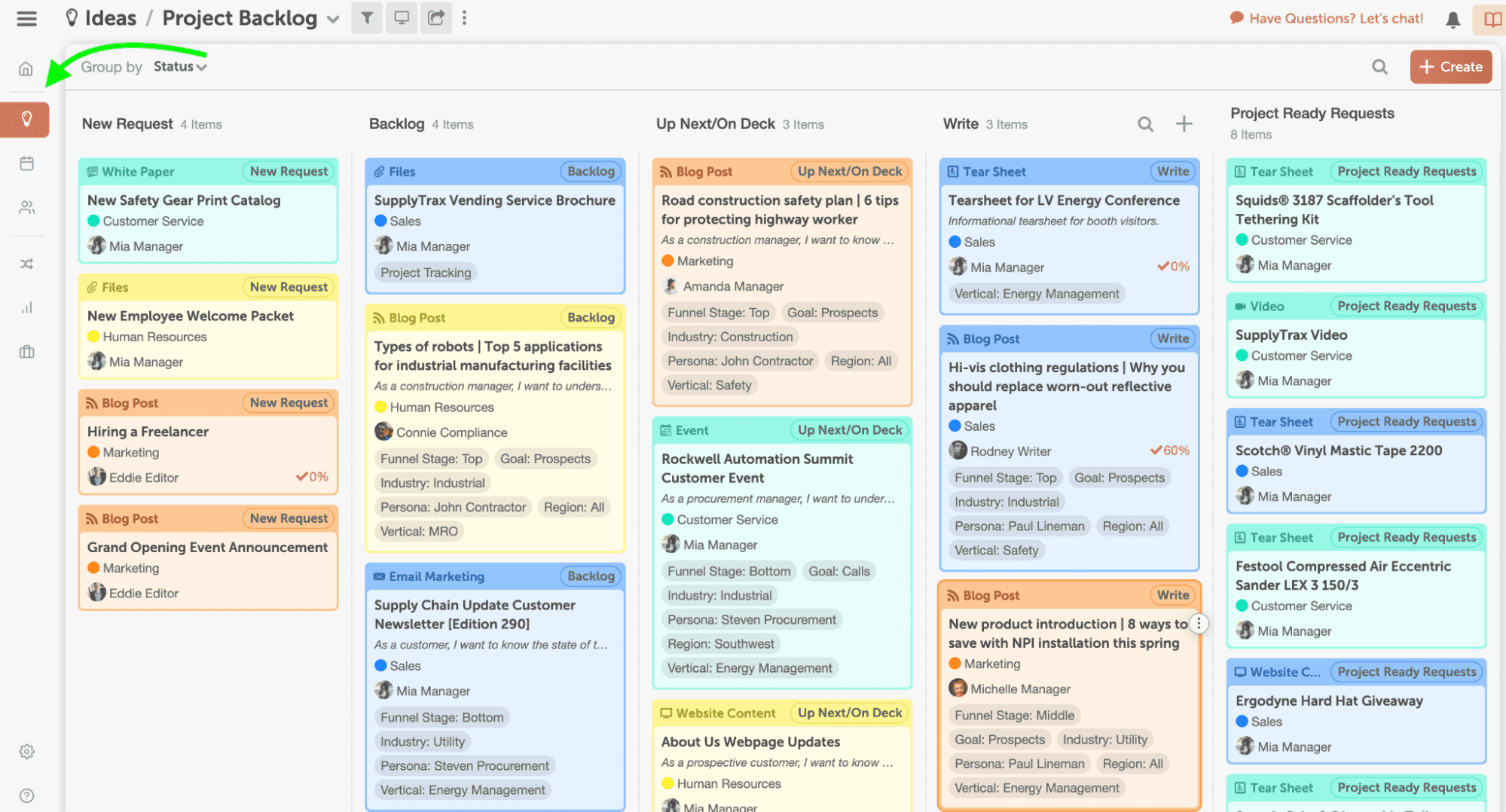
Share updates of your backlog with stakeholders using Read-Only Views. Confirm your team is working on the right priorities & projects.
Then easily assign out these high priority projects and requests to your team as capacity allows.
Measure & Report On Performance
Measure & report on performance insights using Project and Campaign Reports.

Provide your stakeholders with progress updates to showcase the work marketing is doing for a specific team, initiative, goal, region, and beyond.
Manage your marketing resources with Marketing Suite to effectively plan, schedule, ship, and measure projects amongst your team and stakeholders.
Learn more about Marketing Suite or schedule your demo today.
This piece was originally published as a blog post December 19, 2018. It was updated November 2022; June 2023; September 2025. Leah DeKrey, Brier Gurholt, Nathan Bergstrom contributed to this piece.
